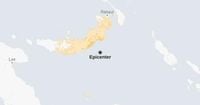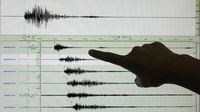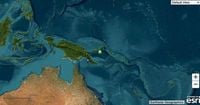A tsunami warning has been cancelled for Papua New Guinea following a strong magnitude 6.9 earthquake that struck off the Pacific nation's coastline on Saturday, April 5, 2025. The earthquake, initially reported as a 7.1 magnitude by the US Geological Survey (USGS), was later revised down. It hit at a depth of 49 kilometers in the New Britain region, approximately 194 kilometers east of the town of Kimbe.
Immediately after the quake, the Pacific Tsunami Warning Centre issued an alert warning of potential waves of up to three meters along parts of the PNG coast. However, this warning was lifted shortly thereafter, with no significant tsunami expected. Additionally, a precautionary alert regarding smaller waves of 0.3 meters for the nearby Solomon Islands was also rescinded.
As of now, there have been no immediate reports of damage on New Britain, which has a population of just over 500,000 residents. This is a relief considering the devastation caused by a similar magnitude-6.9 quake in March 2024, which resulted in three fatalities and the destruction of around 1,000 homes in the East Sepik province.
Papua New Guinea is situated on the Pacific "Ring of Fire," a region known for its high seismic activity, including frequent earthquakes and volcanic eruptions. This geographical characteristic makes the nation particularly vulnerable to natural disasters.
The tremor occurred at 6:04 a.m. local time, and subsequent smaller aftershocks were recorded in the area. The US Tsunami Warning Center had initially cautioned residents to be vigilant, but the situation has since stabilized.
Seismologists continue to monitor the region closely, as earthquakes of this magnitude can lead to aftershocks that may pose additional risks to already vulnerable areas. The USGS confirmed that multiple smaller quakes had occurred following the initial tremor, which is typical behavior for seismic events of this nature.
The earthquake on Saturday has drawn attention not only for its intensity but also for the ongoing seismic activity in the Pacific region. Just a few days prior, tsunami warnings were issued in Tonga after a 7.1 magnitude quake struck the Pacific island, further emphasizing the volatile nature of the area.
In a broader context, the recent earthquakes in the region highlight the need for preparedness and resilience in communities vulnerable to such natural disasters. While the immediate threat has passed, the potential for aftershocks remains a concern for residents and local authorities.
As the world watches, the situation in Papua New Guinea serves as a reminder of the power of nature and the importance of disaster readiness. The cancellation of the tsunami warning is a positive development, but it also underscores the unpredictability of seismic events.
In addition to the recent earthquake in Papua New Guinea, the region has been affected by a series of powerful earthquakes in recent months. For instance, a devastating 7.7 magnitude earthquake struck Myanmar just last week, resulting in over 3,000 deaths and injuring approximately 4,500 individuals. This earthquake was so powerful that it was felt as far away as Bangkok, Thailand, where it caused the collapse of a skyscraper.
Reports from Myanmar detail a dire humanitarian situation, with aid groups calling for immediate assistance to help those affected by the earthquake. The international community has been urged to respond swiftly to the needs of the Burmese people as they recover from this tragedy.
In the wake of these seismic events, experts are reiterating the importance of comprehensive disaster response strategies. They emphasize that timely and effective aid can significantly reduce the impact of such natural disasters on affected populations.
As Papua New Guinea recovers from the latest quake, the focus will likely shift towards assessing the damage and ensuring that the community is prepared for any future seismic activity. Local authorities are expected to conduct thorough evaluations of the infrastructure and implement any necessary safety measures.
The recent earthquake serves as a stark reminder of the challenges faced by nations situated along the Pacific Ring of Fire. With ongoing seismic activity, the residents of Papua New Guinea and surrounding regions must remain vigilant and prepared for any future earthquakes.
In summary, while the tsunami warning has been lifted and no significant damage has been reported, the earthquake's impact will likely resonate within the community for some time. The experience reinforces the need for awareness and preparedness in the face of nature's unpredictability.





